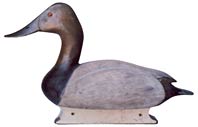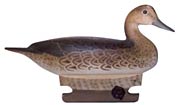by Donna Tonelli
| |
 |
| |
Torry Ward admired the carvings of the Ward brothers of Crisfield, Maryland and became proficient in reproducing their classic hunting decoys. Shown above is one of his high-head canvasbacks. |
Torry Ward grew up living the life boys only dream of. He spent uncountable days in the marsh learning to hunt and trap, activities that he would pursue ardently, for both pleasure and reward, for the rest of his life. Carrier pigeons ferried messages between his home and York Lodge, alerting his father that guests and supplies were arriving on the Great Northern or the Canadian Pacific Railroad at Delta, as it was his responsibility to transport them from the village to the hunting lodge. Torry attended a one-room schoolhouse in Delta.
In 1937 Aldo Leopold, Miles Pirnie and Albert Hochbaum arrived at Delta to complete Bell’s vision of a scientific community that would study ways to protect waterfowl populations and habitat. The Delta Waterfowl Research Center was thus created. Leopold was hired to improve the wild bird hatchery program and brought Pirnie and Hochbaum, both graduate students, along to assist. Torry was among the students who were given hands-on experience in waterfowl studies and game management, setting the direction of his future. At the age of 13, under the guidance of his older sister Joan and her future husband Albert Hochbaum, Torry completed an extensive study of the Snowshoe hare.
Soon after finishing high school, which he attended in Portage Le Prairie 16 miles south of Delta, Torry enlisted in the military, training as a paratrooper. Although it was during World War II, he spent most of his time training and riding motorcycles and never made it overseas.
Torry returned to Manitoba after his tour of duty and became a Provincial Game Warden in the mid-1940s, a time when the marsh was abound with muskrat, fox, mink and other fur-bearing mammals. He ran a trap line of the side to earn extra money. At the urging of his sister Joan, Torry traveled to Denver to study taxidermy at Jonnass Brothers. Arrangements were made for him to stay with her husband’s relatives and a small stipend of family money covered his studies and living expenses.
 |
|
| Perdew style pintail hen with a full hunting keel. |
|
After Torry completed his studies and returned to Portage Le Prairie, it was quickly obvious that he couldn’t earn a decent living there as a taxidermist. So he headed north and took work as a Caterpillar tractor operator. He also drove large shipments of goods to the mining and logging camps in the distant reaches of Manitoba’s frozen northlands. Driving in the northlands was dangerous work. Drivers often were forced to cross over frozen lakes and rivers, risking thin ice, or through muskegs riddled with soft peat bogs. Torry continued to travel the northland for five years until the rich gold mines of Snow Lake, where he worked during the summer months, and a charming girl, Joan Audrey Garrioch, became too attractive to leave.
Torry and Joan married in Portage Le Prairie and settled on Garrick Creek, just south of town, where they raised three children – Terry, Dale and Dennis. Torry operated Caterpillar tractors at the nearby airbase and drove a taxi part time. But he most enjoyed wheeling and dealing in collectibles, anything from old cars, to guitars and pianos, to decoys and guns - about anything he could make a buck on. His entire family was well versed in handling collectibles and became polished musicians talented at a variety of musical instruments. Family lore contends that his daughter had so many shotguns and rifles hid in her bed that it broke, leading Torry to sell the entire collection and buy a Buick Continental convertible. While it may seem he led the life of a no account, Torry was extremely industrious. One of his prize possessions was a belt buckle he earned when he drove a delivery truck for MacGabins Bread. It read: “You can’t have bread and loaf too.”
| |
 |
| |
Turned head bluebill.
|
Torry’s first decoys were carved of native cedar, but carvers he met at the decoys shows in the States encouraged him to try softer, lighter woods, like sugar pine or balsa. He also incorporated new painting techniques, like combing and feather blending, and switched from oil and lead-based paints to acrylics, which dry much faster. And unlike the old-time makers, who only made decoys for what they hunted, Torry experimented with almost every species of waterfowl, from ducks and geese to swans and grebes.
Torry especially liked the decoys by the Ward brothers and became proficient in reproducing their classic decoys. They are branded L.T. Ward, and since his initials match those of Lemuel T. Ward, these decoys cause confusion for some collectors today. These Ward reproductions initially sold for $50 apiece. At the time of his death in 1990, he charged $150. To Torry’s biggest fans and collectors today, they are treasures.
A special thanks to Torry’s nephew, George Hochbaum, who shared his family history and photographs of his uncle. Without his help, this story wouldn’t have been told.
For the complete story, please see the March/April 2002 issue of Decoy Magazine.
Tidbits Main Index

|


